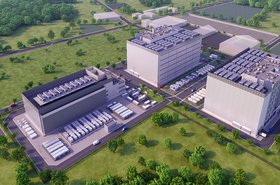Spanish startup YPlasma has secured $2.5 million in seed funding to further develop its fanless plasma-based cooling technology.
The round was led by deep tech venture capital Faber, with participation from global VC firm SOSV. The funding will support the expansion of YPlasma’s research and development.
Launched in 2024, the company was spun out of the Spanish space agency, the National Institute for Aerospace Technology (Instituto Nacional de Técnica Aeroespacial, or INTA). The firm is looking to offer a replacement for fans inside servers that could give air-cooling an efficiency and reliability boost by using electrostatic fields to convert electrical current into airflow.
Its Dielectric Barrier Discharge-type plasma actuators generate ionic wind that can provide cooling in a small form factor with no moving parts and require minimal power.
The first commercial integration, expected by the end of 2025, will target consumer electronics such as laptops and similar devices. The company has previously told DCD it is also exploring potential use in servers – with Edge deployments in dirty environments a potential avenue.
David Garcia, YPlasma co-founder and CEO, said: “We’re delighted to partner with Faber and SOSV to unlock the full potential of plasma actuator technology across multiple industries. With this funding, we’re bringing a fundamentally new approach to thermal management and flow control to market—one that’s solid-state, scalable, and rooted in deep science. Plasma actuators can unlock efficiency gains across industries, from electronics to aerospace, and we’re just beginning to scratch the surface of what’s possible.”
A DBD is composed of two thin copper electrode strips, with one surrounded by a dielectric material such as Teflon. The actuators can be between just 2-4 mm thick.
When you apply high voltage, the air around the actuator ionizes, creating plasma just above the dielectric surface. This can produce a controllable laminar airflow of charged particles known as ionic wind that can be used to blow cold air across electronics.
The direction and speed can be controlled by changing the voltage going through the electrodes. Garcia says the actuator’s ionic wind can reach speeds up to 40km per hour, or around 10 meters per second.
In the IT space, the company is looking at using its actuators to force air across chips, removing the need for fans. This could potentially save space and power, offering greater reliability than fan-based systems, and removing vibrations, which could increase hardware lifespans. The company says its DBD actuators can match or exceed the heat dissipation capabilities of small fans.
Niklas Körner, partner at Faber, said: “YPlasma’s solid-state approach to flow control and heat management brings genuine innovation to a space long overdue for disruption. The combination of scientific depth, engineering talent, and global ambition made this an easy decision for us. We’re thrilled to support their journey.”
Previous investors in YPlasma include SOSV/ HAX and Esade Ban, which both contributed to seed rounds totaling €1.1m ($1.2m) in 2024. Other investors include MWC’s Collider and the European Space Agency’s Commercialisation Gateway.
The likes of Intel, Apple, and chip-packing company Tessera (later renamed and broken out into Xperi Inc. and Adeia) have previously shown interest in plasma-based cooling. Ionic Wind Technologies, a spin-out from the Swiss Federal Laboratories for Materials Science and Technology (Empa), is also looking at developing its own ionic wind amplifier that could be used for chip cooling.
DCD recently spoke to YPlasma about its technology. Read the interview here.
More in Investment / M&A / Financing
Read the orginal article: https://www.datacenterdynamics.com/en/news/yplasma-secures-25-million-for-plasma-based-cooling-technology/









